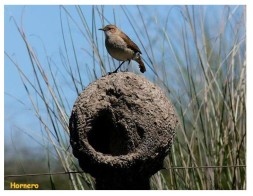WHAT DO YOU WANT TO BE?
I am the first architect in my family. I spent my childhood in a small village in the Argentine pampas where there were no architects; the first stimulus to become one did not originate in the observation of building but of nature. Everyone in my village knew the inseparable little girls (my cousin and I, six years old, and only one month apart) that were free to roam safely beyond the urban precinct, collecting stones, arrowheads and wild flowers. I was fascinated by birds’ nests and spent long moments analyzing how they were put together. It was an especially exciting moment when I caught sight of a bird working on its dwelling. I saw many different kinds of nests, placed in different kinds of places: high and low; hidden and exposed;large and small. Different birds also chose different materials. The most complex and mysterious to me were those made entirely of mud mixed with dry leaves, hair, straw and bits of roots. They looked like primitive bread ovens, and the birds that made them were called horneros (oven-makers). I tried to replicate them with my own hands but my attempts were an utter failure. My “oven-nests” would collapse because I didn’t know that they were built in layers that needed to settle to become structural. Instead of modeling the entire shape at once, as I had tried to do in my six-year old impatience, the horneros would calmly build layer upon layer for over a week with their beaks to complete those beautiful sculptures, which would then be abandoned after their offspring had become too big to fit inside. So I mostly imitated nests made out of twigs, learning how these would have to be woven so the form would not disintegrate when picked up. I believe my interest in vernacular building techniques originated in these early experiments.
I mentioned the nest building of my childhood in an interview that inspired a Guatemalan-American illustrator, Juliet Menendez, to create a poster of Susana Torre, Architect, as a child with a nest in her hands, being visited by the nest’s would be dwellers. It is part of a series on Latina leaders that Ms. Menendez hopes to place in the corridors and classrooms of New York City elementary schools. Role models are usually imagined as successful grown-ups but here the role model is a child who doesn’t know what she will become as a grown-up. The illustrator’s poetic leap is to recognize in the child’s curiosity the germ of the adult’s professional commitment, and to make a child in another time and place become aware of the way in which her own curiosity and interests may illuminate the path towards a future vocation.
reply? please send me an e-mail

